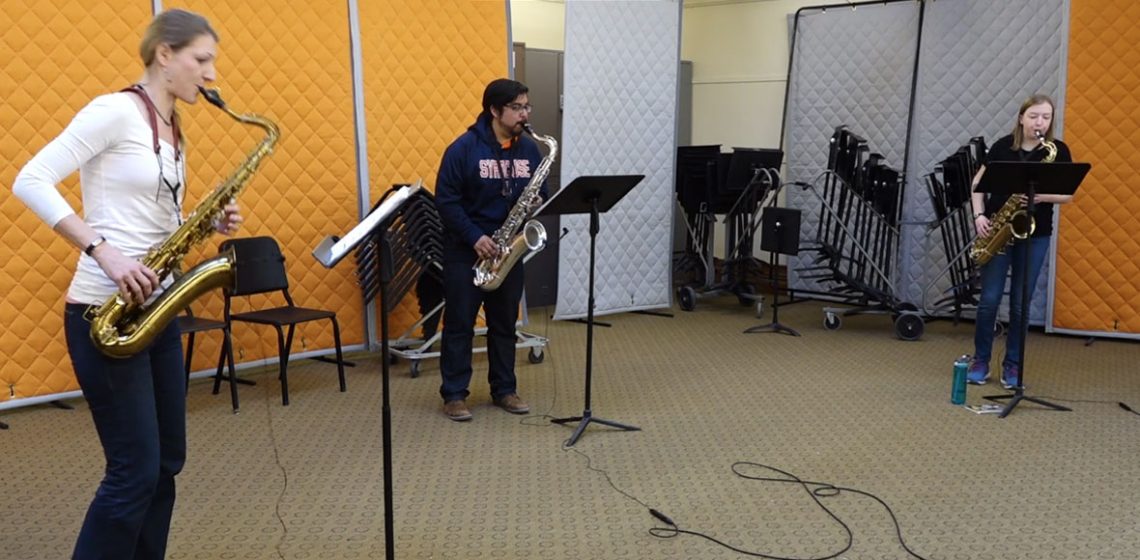Composer Nicolas Scherzinger finds inspiration for his work in many places. For one of his latest works, “Three Really Mad Tenors,” he found it in two places—in “Tenor Madness,” a duo jazz album by tenor saxophonists Sonny Rollins and John Coltrane, and in The Three Tenors operatic singing group of Plácido Domingo, José Carreras and Luciano Pavarotti.

Scherzinger, associate professor in the Setnor School of Music in the College of Visual and Performing Arts, first composed the piece in 2015 and premiered it that summer at the World Saxophone Congress in Strasbourg, France. An inclusive music performance for tenor saxophones and interactive computer, it will be one of 13 performances at ACCelerate: The ACC Smithsonian Creativity and Innovation Festival.
The festival will be held April 5-7 at the Smithsonian Institution’s National Museum of American History in Washington, D.C. Virginia Tech’s Institute for Creativity, Arts and Technology and the Smithsonian’s National Museum of American History’s Lemelson Center for the Study of Invention and Innovation will host the festival.
ACCelerate is a celebration of creative exploration and research at the nexus of science, engineering, arts and design among the 15 colleges and universities in the Atlantic Coast Conference (ACC). More than 40,000 visitors to the museum are anticipated over this three-day event. The festival will feature 38 interactive installations and 13 performances grouped in three thematic areas: Exploring Place and Environment; Exploring Health, Body and Mind; and Exploring Culture. Scherzinger is one of three Syracuse faculty members to perform or exhibit in the festival.
For the performance, School of Music instructor Diane Hunger, senior Leah Haines and graduate student Nieves Villasenor will play tenor saxophones. They read the same music throughout the entire piece, but will rarely line up and are often out of sync with one another.
The fourth element of the piece is the computer—Scherzinger’s role—which will capture the sound of the three tenor saxophones in various ways and add effects. Almost all the sounds processed by the computer come from the live performers.
At various high points in the piece, it sounds like there are as many as 30 saxophones all playing at the same time, but never in unison. “It is probably the most obnoxious piece I have ever composed,” Scherzinger jokes.
For Scherzinger, the evolution of “Three Really Mad Tenors” was a process. He attempted to write a trio for either soprano, alto and tenor saxophones or alto, tenor and baritone saxophones, without success.
“I became very excited about writing a trio for three like saxophones, in this case three tenor saxophones,” Scherzinger says. He looked to the Rollins/Coltrane and Domingo/Carreras/Pavarotti collaborations for inspiration.
“In both the jazz album and with the operatic tenors, the soloists play/sing the same music at the same time, either in the form of a jazz head (song) or operatic aria. This is at the heart of ‘Three Really Mad Tenors,’” he says.
This is the third and final version of the piece, Scherzinger says. Audiences get a different experience each time, as the saxophonists bring their own interpretations into their performances.
Scherzinger says he and his colleagues are very much looking forward to the festival. “We are excited to be performing in a space at the Smithsonian,” he says.
The 20-minute performance will take place on Friday from 4 to 4:45 p.m. on the Coulter Plaza Stage at the ACCelerate festival. The audience is invited to move in and around the performers during the performance. Scherzinger hopes to present a performance of “Three Really Mad Tenors” in Syracuse in the near future.
